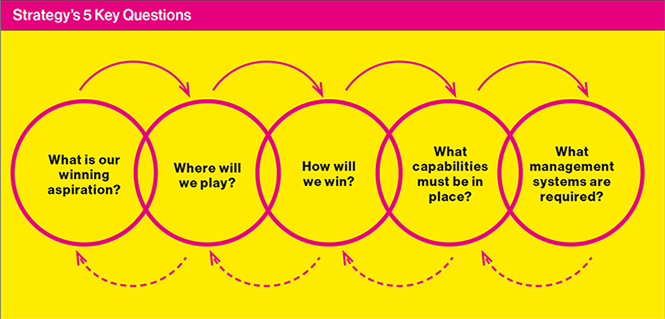 THOSE WHO KNOW ME WELL know that I have a love/hate relationship with all things strategic. On the one hand, I hate ‘strategic planning’ and traditional strategic plans; but on the other, I absolutely love strategy. At heart, I’m a ‘strategy guy’, but the practices involved in strategic planning leave me cold — and the reason is, the typical strategic plan isn’t terribly useful.
THOSE WHO KNOW ME WELL know that I have a love/hate relationship with all things strategic. On the one hand, I hate ‘strategic planning’ and traditional strategic plans; but on the other, I absolutely love strategy. At heart, I’m a ‘strategy guy’, but the practices involved in strategic planning leave me cold — and the reason is, the typical strategic plan isn’t terribly useful.
Most strategic plans have three sections. The first is some lofty vision or mission statement, and the middle section tends to be a list of initiatives: ‘Here are a bunch of things we’re going to do’. Sometimes that’s good, because it is action-orientated, but if you look at most strategic plans — at least the ones I’ve seen — you can almost see how the list of initiatives came to be. There is a little bit in there for marketing and a little bit for manufacturing and a little bit for finance; it is basically a list of compromises that were made by a bunch of people sitting around a table saying, ‘We want to do this’, and ‘We want to do that’. Then lastly, there are the financials, which I often refer to as ‘a budget written in prose’. I don’t find any of this very helpful in terms of laying out the key choices that a firm needs to make.
The second aspect of strategic planning that I’m not nuts about is that it is so cost-driven. If you think about a typical income statement, it indicates revenues and then there are a bunch of categories and expenses, cost of goods sold, R&D and depreciation, to get your profit-before-taxes, and then taxes and net profit. Because all of these categories appear on one statement, they are implicitly thought of as ‘one thing’. But if you break it down, you come to realize something very important: Some of these items are completely within the company’s control, while others are not — at all.
Expenses are completely within a company’s control. A firm can decide exactly how much in the way of raw materials to purchase, how many people to hire, how many square feet of office space or manufacturing space they need; all of those are completely within the company’s control, so you can actually plan for these things. On the other hand, sales targets are entirely dependent upon customers. You can hope for future sales. You can say, ‘We want to hit one billion dollars in sales this year’, or $10 billion — as much as you want; but that is not going to make it happen.
The problem is, these ‘two sides’ of the income statement are treated similarly, as if we can plan for sales and expenses in the same way. But in reality, you can’t. Sales will come from making choices that compel customers to want to buy your products. Yet we never see any mention of that in any strategic plan.
The last thing I’m not nuts about is the popularity of a couple of self-referential frameworks for ‘doing’ strategy. One is ‘emergent strategy’. Henry Mintzberg — one of the finest management scholars of all time — came up with the notion that strategy is more ‘emergent’ than we might like to think. What he observed was that with strategy, companies may think that they’re going to predict and organize the future, but often, when you look backwards, your actual strategy changed and shifted, based on emergent conditions in the marketplace. This is a great insight.
Unfortunately, some strategic planners have taken it to mean that ‘You shouldn’t bother planning ahead’. That is not what Mintzberg meant, and it is an unhelpful view of the world. What he meant is that the world will forever be emergent, and as a result, waiting until ‘what to do next’ becomes crystal clear is like waiting for Godot. He will never show up. You have to make some choices.
The second theory that causes a lot of confusion is the resource-based view of the firm that is currently popular among strategy scholars. This theory focuses on capabilities rather than customer-driven investment. Simply put, you identify your capabilities and say, ‘Hopefully they are valuable, rare and non-substitutable, and therefore we will be successful’. This mindset makes it easy to think about investing in capabilities; but a capability is only useful to the extent that customers value it, and as a result, this is unhelpful.
It might make leaders feel very comfortable to believe that they can organize everything to their liking and plan for future revenue. It feels good to think, ‘If we build resources, good things will happen’ and ‘If we have a long-term strategic plan, we have a good strategy’. But in my experience, that’s not how it works.
Waiting until ‘what to do next’ becomes crystal clear is like waiting for Godot.
The first thing to keep in mind about strategy is that it is not all that complex. You should keep it simple and always remember that, put simply, strategy is about choices. After years of working closely with leaders of large corporations, I have come to the conclusion that strategy is actually about a set of five choices that must be made:
1. What is our winning aspiration?
2. Where will we play?
3. How will we win?
4. What capabilities must be in place?
5. What management systems are required?
The very core of any strategy is the world of question #3 — the ‘how to win’ choices: Where are you going to place yourself on the playing field, and how are you going to win there? Answering that question is the hardest part of strategy.
You don’t need a 100-page strategic plan. In fact, there is no good reason why your strategy can’t be written on one page. No amount of number crunching and forecasting will help if you don’t make these five choices. Only by making them will customers find themselves compelled to give you their money; and if they don’t do that, you’ve got nothing.
My most important rule around the five choices is this: If the opposite of your choice is patently stupid, then it isn’t a valuable choice at all. For instance, if your choice is to ‘be customer-centric’, the opposite of that would be to ‘ignore customers entirely’ — which is unquestionably stupid. All you’ve really done is made a choice to be non-stupid, and that is never a useful strategy choice.
However, if you say, ‘We are going to define customer service in a new way that is entirely different from our competitors, because we believe that an important segment of customers care very much about that’ — that is a real choice.
My second takeaway is that strategy is not about perfection. It is not meant to be an analytical exercise that gets you the facts, so that once you’ve analyzed ‘what is true’, you just have to do X and you will be successful. Strategy is about the future, and the future is never going to be exactly the same as the past. That’s why you’ve got to combine analytical rigour with creativity to get to the best possible answer.
Of course, there are still parts of the world where, as Aristotle said 2,500 years ago, ‘things cannot be other than they are’. In these cases, it is true that the strategist’s job is only to analyze, because things are not going to be any different next year than they are today. Water will continue to flow downhill — forever. You can make choices with certainty when they are based on things that you know to be 100 per cent true.
However, there is a whole other part of the world where things can — and likely will be — other than they currently are. If you look around today, many of us are attached at the hip to our smartphones. And yet, prior to 1999, there was no such thing. This is a prime example of the part of the world where things can be other than they are, and in this part of the world, you cannot analyze your way to a perfect answer. You can’t say, ‘We have done the analysis, and we have come up with the right answer’.

What you can do is imagine possibilities and make choices that you believe to be the most compelling you can make. Sometimes you will be right, and sometimes you will be wrong. That is the nature of strategy, because that is the nature of life. If you insist on perfect planning, you are deluding yourself into thinking that the future will be the same as the past. Sadly, in my experience, this is a mistake that many companies make.
My third takeaway principle is to always make your strategic logic explicit. When you are looking at a few particular possibilities, rather than asking, ‘Which is most true?’, you should ask, ‘What would have to be true about the world in order for this to be a great idea?’ That is how to make your logic explicit.
Analysis is all about applying facts or data to logic, and people often think of strategy as being mostly analytical. But when they do, they often forget about testing their underlying logic. The challenge is to figure out ‘What 10 things must be true for this strategy to be a great one?’ Your answers might be things like, ‘Customers will have to behave this way; the distribution channel will have to value X; competitors will have to not do Y’, etc.
Once you’ve completed this exercise, you can then figure out which of the things that ‘have to be true’ are the most worrisome, and figure out how to address them. How can you make it true that customers will value your product? Well, you could go out and work directly with them, give them more information about the benefits, gather more data, etc.
One of my favourite assignments ever was working with Herman Miller when it launched the Aeron chair, which changed office chairs forever. Initially, when shown the chair, people hated it. The issue was, with its mesh backing and prominent adjustment knobs, it didn’t really look like a chair. The company’s leaders realized that it was up to them to teach people to love this chair. And they did. It went on to become the best-selling office chair in history, and that came from asking, ‘What would have to be true?’, and then figuring out how to make it true.
So, stop aiming for perfection and creating long strategic documents, and focus instead on the few key choices you need to make. Don’t try to be perfect in a world where perfection is impossible. And ask the question, ‘What would have to be true?’ rather than ‘What is true?’. When you do these things, strategy is what it should be: simple, enjoyable and effective, rather than complicated, arduous and ineffective.
Ranked #1 on the Thinkers50 list of the world’s most influential management thinkers,
Roger L. Martin is the Premier’s Research Chair in Productivity and Competitiveness and Academic Director of the Martin Prosperity Institute at the Rotman School of Management. The former Dean of the Rotman School (from 1998 through 2013), he is the author of several best selling books, most recently,
Creating Great Choices: A Leader’s Guide to Integrative Thinking (Harvard Business Review Press, 2017), co-authored with Jennifer Riel.
This article appeared in the Fall 2018 issue. Published by the University of Toronto’s Rotman School of Management, Rotman Management explores themes of interest to leaders, innovators and entrepreneurs.
Share this article: